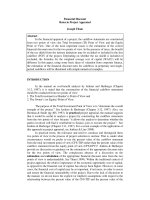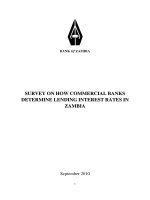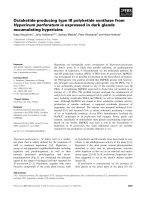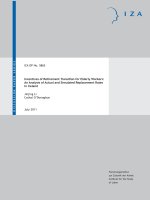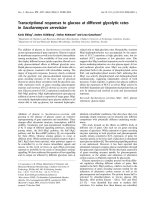NEUTRALINO EVENT RATES IN DARK MATTER DETECTORS
Bạn đang xem bản rút gọn của tài liệu. Xem và tải ngay bản đầy đủ của tài liệu tại đây (110.61 KB, 18 trang )
<span class="text_page_counter">Trang 1</span><div class="page_container" data-page="1">
arXiv:hep-ph/9408226v1 3 Aug 1994
CERN-TH.7362/94CTP-TAMU-37/94NUB-TH-3098/94NEUTRALINO EVENT RATES IN DARK MATTER DETECTORS
mat-* Permanent address
</div><span class="text_page_counter">Trang 2</span><div class="page_container" data-page="2">1. INTRODUCTION
There is much astronomical evidence that more than 90% of our Galaxy,and perhaps of the universe is made up of dark matter of unknown type. Ingalaxies, this matter has been detected by its gravitational effects on themotion of stars and gas clouds. A large number of candidates for dark mat-ter have been suggested both from astronomy and particle physics. In thispaper we will limit our discussion to supersymmetry models with R parity, asthey offer a natural candidate for dark matter, the lightest supersymmetricparticle (LSP) which is absolutely stable. Thus the relic LSP left over fromthe big bang could be the dark matter present today. Further, in super-gravity GUT models, for almost all the parameter space of most models, theLSP is the lightest neutralino, the ˜Z<small>1</small>. (The alternate possibility, that thesneutrino is lightest occurs only rarely.) Thus we will consider here only the
A great deal of work has already been done on the question of darkmatter detector rates [1-7]. We present here an analysis over the entireSUSY parameter space with tan β ≤20 which takes into account severalimportant effects not generally treated before:
• Radiative breaking. Almost all previous analysis has been done withinthe framework of the MSSM which does not include the constraints ofradiative breaking of SU(2)xU(1). These constraints allow the deter-mination of µ<small>2</small> and m<sub>A</sub> (µ is the H<small>1</small> − H<small>2</small> Higgs mixing parameter, Ais the CP odd Higgs boson) in terms of the other parameters. (Some
</div><span class="text_page_counter">Trang 3</span><div class="page_container" data-page="3">previous analyses have varied m<small>A</small> arbitarily, obtaining spuriously largeevent rates.)
• As pointed out in Refs. [6,7] the heavy neutral Higgs, H, can make animportant contribution to the event rates. We have included this for theentire parameter space and find that the H contribution relative to thelight Higgs, h, can range from 1/10 to 10 times as large.
• As is well known, loop corrections to m<small>h</small> are important due to the factthat the t quark is heavy [8]. We have also included the loop correctionto ˜α (the rotation angle arising in diagonalizing the h-H mass matrix).These actually cancel much of the effects of the loop corrections to m<sub>h</sub>.• The COBE constraints on the ˜Z<small>1</small>relic density are included. This strongly
limits the region of SUSY parameter space that is allowed. In ing these relic density constraints it is essential to include the effects ofthe h and Z s-channel poles [9-11] for gluinos with mass m<small>˜g</small><<sub>∼ 450 GeV.</sub>There are several effects we have not included here. Most noteworthyare that we have ommitted the possible WW, ZZ, Zh, hh final states in the
Z<small>1</small> annihilation for the relic density calculation (which can occur when m<small>Z˜</small><sub>1</sub>
gets to the upper end of its allowed spectrum i.e. m<small>Z˜</small><sub>1</sub>>
∼M<small>W</small> and we havefollowed Refs. [12,13] in calculating the relic density. We estimate that thismay lead to a (25-30)% error in the relic density, and since we have beenreasonably generous in the allowed values for the relic density, we expect thiswill not significantly change our final conclusions. We also discuss below thesensitivity of the results to changes in the allowed region of ˜Z<small>1</small> relic density.II. RELIC DENSITY CONSTRAINT
The COBE data suggests that dark matter is a mix of cold dark matter,CDM, (which we are assuming here to be the relic ˜Z<small>1</small>) and hot dark matter,HDM (possibly massive neutrinos) in the ratio of 2:1. In addition there mayalso be baryonic dark matter, B, (possibly brown dwarfs) of amount <<sub>∼ 10%</sub>of the total. Defining Ω<sub>i</sub> = ρ<sub>i</sub>/ρ<sub>c</sub>, where ρ<sub>i</sub> is the mass density of the i<small>th</small>
constituent and ρ<small>c</small> = 3H<small>2</small>
/(8πG<small>N</small>) [H = Hubble constant, G<small>N</small> = Newtonian
</div><span class="text_page_counter">Trang 4</span><div class="page_container" data-page="4">constant] is the critical mass density to close the universe, then the ary scenario requires ΣΩ<small>i</small> = 1. A reasonable mix of matter is then Ω<small>Z˜1</small> ≃ 0.6,Ω<small>HDM</small> ≃ 0.3 and Ω<small>B</small> ≃ 0.1. What can be calculated theoretically is Ω<small>Z˜</small><sub>1</sub>h<small>2</small>
inflation-where h = H/(100 km/s Mpc). Astronomical observations give h = 0.5-0.75.Thus we are lead to the estimate
Eq.(1) strongly resticts the allowed SUSY parameter space, and thus itis necessary to have a satisfactory method of calculating Ω<small>Z˜1</small>h<small>2</small>
. (We willdiscuss below the effects of varying the maximum and minimum values ofΩ<small>Z˜</small><sub>1</sub>h<small>2</small>.) To do this, we use supergravity GUT models [14]. These modelshave the advantage of being consistent with the LEP results on unificationof couplings at M<small>G</small> ≃ 10<small>16</small>
GeV [15], and generate naturally spontaneousbreaking of supersymmetry in a hidden sector. In addition, by use of therenormalization group equations (RGE), the supersymmetry breaking inter-actions at M<small>G</small> produce naturally spontaneous breaking of SU(2)xU(1) at theelctroweak scale M<small>Z</small>. In general, the low energy supersymmetry theory de-pends on only four parameters, m<small>o</small>, m<small>g˜</small>, A<small>t</small>, tanβ, and the sign of µ. Herem<sub>o</sub> is the universal mass of all scalar fields at M<sub>G</sub>, A<sub>t</sub> is the t-quark cubicsoft breaking parameter at the electroweak scale, and tan β = hH<small>2</small>i/hH<small>1</small>iwhere hH<small>2,1</small>i gives masses to the (up, down) quarks.
The above may be contrasted with the MSSM (the formalism most darkmatter calculations use) which possesses no theoretical mechanism for SUSYor SU(2)xU(1) breaking and is generally parameterized by 20 aribtrary con-stants. In the supergravity models, all properties of the 32 SUSY particles(masses, widths, cross sections, etc.) are determined in terms of the four ba-sic parameters and one sign. In particular, this means that m<small>A</small> and µ are sodetermined and are not free parameters (as usually assumed in the MSSM).Further, one finds throughout most of the parameter space the following(approximate) relations [16]:
</div><span class="text_page_counter">Trang 5</span><div class="page_container" data-page="5">∼= m<small>Z˜2</small>
= m<small>W˜1</small> ≃ (<sup>1</sup>4 <sup>−</sup>
The calculation of Ω<small>Z˜1</small>h<small>2</small>
now proceeds in a standard manner. Usingthe RGE, we first express all SUSY masses and couplings in terms of thefour basic parameters. This is done for the parameter space over the range
150GeV ≤ m<small>g˜</small> ≤ 1T eV ; 100GeV ≤ m<sub>o</sub> ≤ 1T eV ; −2 ≤ A<sub>t</sub>/m<sub>o</sub> ≤ 6; 2 ≤ tanβ ≤ 20(3)with a mesh ∆m<small>o</small>= 100 GeV, ∆m<small>g˜</small>= 25 GeV,∆(A<small>t</small>/m<small>o</small>) = 0.5, and ∆(tanβ)= 2 or 4. We assume a top quark mass of m<sub>t</sub> = 167 GeV, and LEP and CDFbounds are imposed on the SUSY spectrum. The A<small>t</small> range stated aboveexhauts the parameter space. Note that our analysis does not assume anyspecific grand unification group but only that it is α<small>1</small> ≡ (5/3)α<small>Y</small> that unifiesat M<sub>G</sub>. in the early universe, the ˜Z<small>1</small> is in equilibrium with quarks, leptons,etc. When the annihilation rate falls below the expansion rate, “freezeout”occurs at temperature T<small>f</small>. The ˜Z<small>1</small> then continues to annihilate via s-channelh and Z poles ( ˜Z<small>1</small>+ ˜Z<small>1</small> → h, Z → q ¯q; ℓ¯ℓ; etc.) and t and u-channel squarkand slepton poles. The relic density at present time is given by [13]:
dx < σv >; x = kT /m<small>Z˜</small><sub>1</sub> (5)Here σ is the annihilation cross section, v is the relative velocity and<> means thermal average. Since annihilation occurs non-relativistically,
</div><span class="text_page_counter">Trang 6</span><div class="page_container" data-page="6">x<small>f</small> ≈ 1/20, one may take the thermal average over a Boltzman distribution.However, as stressed in Refs. [9,10,11] one cannot generally make the non-relativisitic expansion σv = a + bv<small>2</small>
+ ... due to the presence of the narrow hand Z s-channel poles. Thus calling Ω<sub>approx</sub> the evaluation using the low vexpansion, and Ω the rigorous result, we find for µ > 0 that the relation 0.75≤ Ω<small>approx</small>/Ω ≤ 1.25 is satisfied for only 35 % of the mesh points for m<small>˜g</small> <450 GeV, but for almost 100 % for m<small>˜g</small> > 450 GeV. The reason for this canbe seen from Eq. (2). One is close to an s-channel pole when 2 m<small>Z˜</small><sub>1</sub> ≈ <small>1</small>
is near m<small>h</small> or M<small>Z</small>. Since m<small>h</small><<sub>∼130 GeV, this cannot happen when m</sub><sub>˜</sub><sub>g</sub>><sub>∼450</sub>GeV but one is usually somewhat near either an h or Z pole when m<small>˜g</small><
∼ 450GeV. Thus a rigorous calculation is necessary for lower mass gluinos.
The annihilation cross section σ can be expressed in terms of the fourbasic parameters m<small>o</small>, m<small>˜g</small>, A<small>t</small> and tan β. Using then Eq. (4) the region inparameter space obeying the COBE constraint of Eq. (1) can be determined.III. EVENT RATE CALCULATION
Dark matter detectors see the incident ˜Z<small>1</small> from effects of its scatteringon quarks in the nuclei of the detector. This scattering proceeds throughs-channel squark poles ( ˜Z<small>1</small> + q → ˜q → ˜Z<small>1</small> + q) and t-channel h, H and Zpoles. These are some of the crossed diagrams to the annihilation diagramsappearing in the relic density analysis. Thus to a rough approximation, onemay expect the event rate to be large when the annihilation cross section islarge i.e. when Ω<small>Z˜</small><sub>1</sub>h<small>2</small> is small. This makes results somewhat sensitive towhere the lower bound on Ω<small>Z˜</small><sub>1</sub>h<small>2</small> is set, and we will discuss this below.
The scattering diagrams have been analysed by a number of people [1-7],and we follow the analysis of Ref. [5].* One may represent the diagrams bythe effective Lagrangian
L<small>ef f</small> = ( ¯χ<small>1</small>γ<sup>µ</sup>γ<sup>5</sup>χ<small>1</small>)¯qγ<sup>µ</sup>(A<small>q</small>P<small>L</small>+ B<small>q</small>P<small>R</small>)q + ( ¯χ<small>1</small>χ<small>1</small>)C<small>q</small>m<small>q</small>q ¯q (6)* We include an extra factor of 4 in the cross section, due to the Majorananature of the ˜Z<small>1</small>, in agreement with Ref. [7].
</div><span class="text_page_counter">Trang 7</span><div class="page_container" data-page="7">where q(x) is the quark field, m<small>q</small> is its mass, and χ<small>1</small>(x) is the ˜Z<small>1</small> field. A<small>q</small>
and B<small>q</small> arise from the Z t-channel pole and ˜q s-channel pole, and C<small>q</small> from theh, H t-channel poles and ˜q s-channel pole. Expressions are given for A,B,Cin Ref. [5]. The first term of Eq. (6) give rise to spin dependent incoherrentscattering while the second term gives rise to coherrent scattering. Thereare several points to be made concerning the latter amplitude. In general,the ˜Z<small>1</small> is a linear combination of two gauginos and two Higgsinos:
χ<small>1</small> = α ˜W<small>3</small>+ β ˜B + γ ˜H<small>2</small>+ δ ˜H<small>1</small> (7)The α, β, γ, δ can all be calculated in terms of the four basic parameters, andthroughout the allowed part of the parameter space one finds
The coefficient C<small>q</small> for the h and H poles is [17]:
C<sub>q</sub> = <sup>g</sup>
<small>cos ˜αsinβ</small>
−<sup>sin ˜</sup><sub>cosβ</sub><sup>α</sup> <sup>F</sup><small>h</small>
<small>sin ˜αsinβ</small>
<small>cos ˜αcosβ</small>
<small>H</small> >> m<small>2h</small>.For the d-quarks, the h term is reduced by a factor tan ˜α relative to the Hterm. Further, the second fact in F<small>h</small> is small, either because γ is small or
</div><span class="text_page_counter">Trang 8</span><div class="page_container" data-page="8">sin ˜α is small. Thus for d-quarks, the H contribution can range from 1/10 to10 times the h contribution, depending on the point in the parameter space.[For u-quarks, the H term is generally small.]
The total event rate is given by [5]
R = (R<small>coh+Rinc</small>)[ρ<small>Z˜1</small>/(0.3GeV cm<sup>−3</sup>)][< v<small>Z˜1</small> > /(320km/s)][events/kgda](10)where the coherrent and incoherrent rates are
R<small>coh</small>= 16 <sup>m</sup><sup>Z</sup><sup>˜</sup><small>1</small>M<small>2N</small>M<small>4</small>
(M<sub>N</sub> + m<small>Z˜1</small>)<small>2</small>210ζ<small>ch</small>| M<small>coh</small> |<small>2</small>
R<small>inc</small> = 16 <sup>m</sup><sup>Z</sup><sup>˜</sup><small>1</small>M<sub>N</sub>
(M<small>N</small> + m<small>Z˜</small><sub>1</sub>)<small>2</small>580λ<sup>2</sup>J(J + 1)ζ(r<small>sp</small>) | M<small>inc</small> |<sup>2</sup> (11)Here M<small>N</small> is the nuclear mass, ζ(r<small>ch</small>), ζ(r<small>sp</small>) are charge and spin form factorcorrections, J is the nuclear spin and λ is defined by < N | Σ
S<small>i</small> | N >= λ <N |
IV. RESULTS
Eq. (11) allows one to divide dark matter detectors into two categories:those sensitive to the incoherrent (spin dependent) scattering due to a largevalue of λ<small>2</small>
J(J+1), and those sensitive to the coherrent scattering. Examplesof “incohererent detectors” are <small>3</small>
He and <small>40</small>
Ca <small>19</small>
F<small>2</small> with CaF<small>2</small> the mostsensitive detector. Eqs. (11) show that R<small>coh</small> ∼ M<small>N</small> and R<small>inc</small> ∼ 1/M<small>N</small>
for large M<sub>N</sub>, the additional M<small>2</small>
<small>N</small> factor in R<sub>coh</sub> arising from the m<sub>q</sub> factorin Eq. (6), i.e. roughly speaking, all the quarks add coherrently to yielda M<small>N</small> factor in the amplitude. The remaining detectors considered here,
<small>76</small>Ge +<small>73</small> Ge, <small>79</small>Ga<small>75</small>As, <small>23</small>N a <small>127</small>I and <small>207</small>P b are all of the “coherrent”type with Pb being the most sensitive since it is heaviest.
</div><span class="text_page_counter">Trang 9</span><div class="page_container" data-page="9">The dependence of the expected event rate on the supergravity GUTparameters is fairly complicated as each parameter enters in several placesand the constraint Eq. (1) on Ω<small>Z˜</small><sub>1</sub>h<small>2</small>
limits the parameter space. One can,however, get a qualitative picture of the parameter dependence by studyingseveral characteristic examples . Fig. 1 shows that R decreases rapidly withm<small>˜g</small> (mainly because the ˜Z<small>1</small> becomes more Bino-like). It also shows that Ris larger for larger tan β. (See e.g. the 1/cos β factor in the denominator ofthe d-quark part of Eq. (9); the 1/sin β factor for the u-quark part nevergets exceptionally large since tan β > 1 in the radiative breaking scenario).Finally we note that R[Pb] is 5-10 times larger than R[CaF<small>2</small>] which is also ageneral feature. The tan β dependence is shown more explicitly in Fig. 2 forthe NaI and Ge detectors. (The three examples were chosen so the Ω<small>Z˜</small><sub>1</sub>h<small>2</small>
isroughly the same at each tan β along each graph). The NaI curve lies higherthan the Ge one for each pair since <small>127</small>I is heavier than <small>76</small>Ge.
In general, the event rate drops with increasing m<sub>o</sub>, as one would expectsince the squark mass increases with m<small>o</small>, reducing the effect of the s-channelsquark pole. (There are additional effects, however, as m<small>o</small> also enters in theradiative breaking equations, effecting the size of µ.) Fig. 3 illustrates thegeneral behavior for several of the detectors. The coherrent detectors, Pb,NaI, Ge, scale almost exactly by their atomic numbers. (Fig. 3 also exhibitsone of the few regions of parameter space where the CaF<small>2</small> detector lies abovethe Pb detector.)
Fig. 4 exhibits the maximum and minimum event rates for the Pb tector (the most sensitive of the coherrent detectors) and the CaF<small>2</small> detector(the most sensitive of the incoherrent detectors) as a function of A<small>t</small>, as allother parameters are varied over the entire space. One sees that generally aPb detector will be a factor of 5-10 times more sensitive than a CaF<small>2</small> detec-tor. Other coherrent detectors have event rates that scale with the Pb curvein proportion to their atomic number while the <small>3</small>He has event rates a factorof 3 smaller than CaF.
</div><span class="text_page_counter">Trang 10</span><div class="page_container" data-page="10">de-The above analysis has been done with Ω<small>Z˜</small><sub>1</sub>h obeying the bounds ofEq. (1). We discuss now the effect of varying these upper and lower limits.As mentioned in Sec. III, the event rate R rises with decreasing Ω<small>Z˜</small><sub>1</sub>h<small>2</small>
and this rise is rapid near Ω<small>Z˜</small><sub>1</sub>h<small>2</small> ≃ 0.1. Further, the maximum value of Roccurs when m<small>˜g</small> is near its minimum value. However, by the scaling relationsEq. (2) this can force m<small>W˜</small><sub>1</sub> < 45GeV , and hence such parameter points areexcluded by the LEP bounds. This is what causes the sharp peaks in Fig.4, which occur when m<small>W˜</small><sub>1</sub> lies just above the LEP cut. If, for example, oneincreases the lower bounds on Ω<small>Z˜1</small>h<small>2</small>
to 0.15, one finds that the maximumevent rates follow the curves of Fig. 4 with the peaks cut off.
The upper bound on Ω<small>Z˜</small><sub>1</sub>h<small>2</small> determines the minimum event rates. Thisis because the minimum rates occur when m<small>g˜</small> takes on its largest value. Asm<small>˜g</small> increases, so does m<small>Z˜</small><sub>1</sub> by Eq. (2). The ˜Z<small>1</small>annihilation cross section thendrops and Ω<small>Z˜</small><sub>1</sub>h<small>2</small> rises. The upper bound of Eq. (1) on Ω<small>Z˜</small><sub>1</sub>h<small>2</small> is found tooccur when (m<small>g˜</small>)<sub>M ax</sub> <sup>∼</sup>= 750 GeV. If one reduces the upper bound on Ω<small>Z˜</small><sub>1</sub>h<small>2</small>to0.2 (which is consistent with the inflationary scenario which prefers h ≃ 0.5).Then the maximum value of m<small>˜g</small> is reduced to * (m<small>g˜</small>)<small>M ax</small> ≃ 400 GeV. Thisthen increases the minimum event rate curves of Fig. 4 by about a factor of10.
V. DETECTION POSSIBILITIES
The above discussion has analysed the expected event rates for a varietyof dark matter detectors over the range of parameters of supergravity GUTmodels. These detectors are most sensistive to the region of parameter spacewhere tan β is large and m<sub>o</sub> and m<small>g˜</small> are small. Two types of detectors werenoted: those with nuclei most sensitive to the spin dependent incoherrentscattering of the ˜Z<small>1</small> (e.g. CaF<small>2</small>), and those most sensitive to coherrentscattering (e.g. Pb). In general, the best of the coherrent scatters are moresensitive than the incoherrent scatterers by a factor of 5-10. The coherrent* Such a low mass gluino could make it accessible to detection at theTevatron.
</div>
